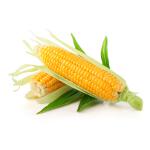Hello all and Happy Friday! We are very excited for next week’s bins! Look forward to more local items, such as purple cauliflower. Yum!
more local items, such as purple cauliflower. Yum!
We’re also anticipating some delicious sweet corn. A staple for summer, sweet corn is the perfect addition to many dishes. It is also one of the most popular veggies among children and adults alike for its sweet flavor.
Did You Know? Adding fresh sweet corn to any dish or serving it on its own is a great way to incorporate more whole grains into your diet – not to mention fiber and folate.This vegetable, although being sweet and delicious, is a great source or many vitamins and minerals. According to WHFoods.org, sweet corn is very rich in vitamin B1, vitamin B5, vitamin C, phosphorus, and manganese. Because of the vitamins contained in sweet corn, many health benefits can be associated with the consumption of this delicious vegetable.
Just how many benefits? Sweet corn helps with your cardiovascular health, cancer prevention, memory enhancement, and vision protection. Let’s find out more about those! (courtesy of Livestrong.com)
Recent studies have shown that sweet corn, it turns out, is one of the very best dietary sources of two antioxidants called lutein and zeaxanthin that help promote healthy vision and protect eyes. Besides protecting against cataracts and chronic eye disease, lutein may help prevent hardening of the arteries that can lead to heart attack and stroke.
Cardiovascular Health
Sweet corn is an excellent source of folate. Folate is commonly known as vitamin B9. According to NaturalHomeRemedies.org, consumption of folate is effective in lowering the homocysteine levels in the body. Homocysteine is an amino acid that can damage the blood vessels. Elevated levels of homocysteine in the body can directly lead to heart attacks, strokes and peripheral vascular disease. Consumption of 100 percent of the daily value of folate can reduce the risk of heart attack by as much as 10 percent.
Cancer Prevention
Memory Enhancement
Sweet corn contains high levels of thiamine, or vitamin B1. According to WHFoods.org, thiamine is an essential nutrient required for brain cell and cognitive function. Consumption of thiamine is necessary for the body to produce acetylcholine. Acetylcholine is a neurotransmitter that is essential for the maintenance of memory capabilities. One of the primary factors associated with Alzheimer’s disease is low levels of acetylcholine.
Vision Protection
According to AusFoodNews.com.au, sweet corn contains the antioxidant zeaxanthin. Zeaxanthin is the yellow pigment that naturally occurs in sweet corn. Consumption of zeaxanthin can have a protective effect against age-related eye diseases such as macular degeneration. In addition, sweet corn also contains folate and beta carotene, which also may protect against macular degeneration.
How will you be cooking your corn this week? Have another favorite item? Share all of your recipes and likes on our Facebook wall!
Also be sure to play our Thursday Trivia Night on Facebook each week for your chance at winning awesome NRO gear! Congrats to Vanessa W. and Wardell B. for winning this week!
**DONT FORGET**
Happy 4th of July! We are going to take that day off, so if you normally get your delivery on Wednesday, it will arrive on Thursday. We have made a few other routing changes for the end of the week, and you will be notified if your delivery day is going to be different, so please check your email.




